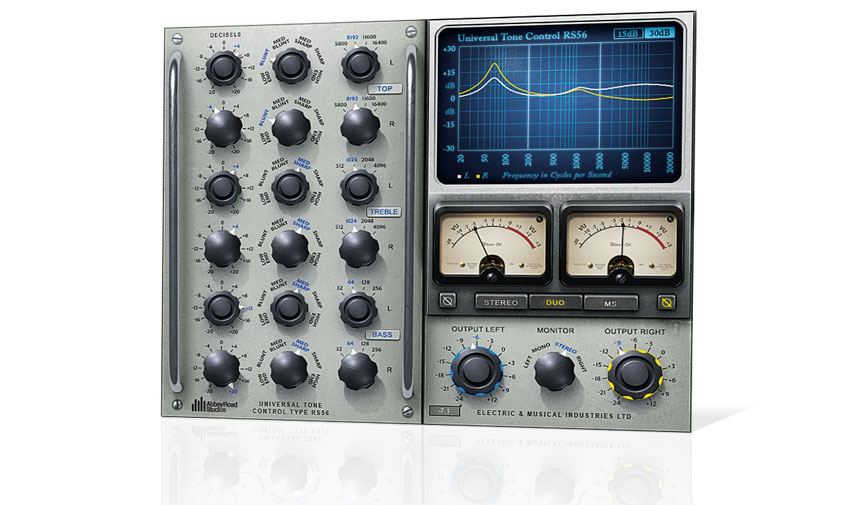MusicRadar Verdict
A hard-hitting alternative to your Pultec emulations, the RS56 suffers only from its archaically restricted frequency settings.
Pros
- +
Choice of four peak shapes. Gentle shelves for sweetening. Surprisingly sharp peak option. Enhanced gain over original hardware. Useful EQ graph.
Cons
- -
Limited frequency selection. Can sound harsh at sharp Q setting.
MusicRadar's got your back
EMI's RS56 UTC (Universal Tone Control) EQ first appeared in 1951. Nicknamed "the Curvebender", it was their attempt at a Pultec- style passive EQ. Initially a mono unit, followed later by a stereo sibling, it offered three bands (Top, Treble and Bass), each with four stepped frequency settings (in octaves from 32-8092Hz, with a couple of extras at 5600Hz and 11200Hz) and up to +/-10dB gain in 2dB steps. Each band had four peak shapes to choose from (Blunt, Med Blunt, Med Sharp and Sharp) and two shelves (Low End and High End).
With its new plugin emulation of the RS56 (VST/AU/RTAS), Waves has stayed largely faithful to the original design, but its supersized the gain (now +/-20dB in 0.1dB increments) and added further new features in a foldaway panel, including an EQ graph and peak/VU output metering.
The plugin comes in mono and stereo versions, and the latter includes three modes (Stereo, Duo and MS) with phase reverse and four output options (mono, stereo and individual monitoring of each of the two channels). Rounding things off are output level controls and per-band bypass controls.
Sweet spot
There are a few interesting aspects to the RS56's design. Every band has a high and low shelf, enabling you to gently 'tilt' the EQ in all sorts of interesting places. Then, the four peak bandwidths range from very gentle (Blunt) to really pointy (Sharp), with the last considerably sharper than can be achieved with the Pultec EQP-1A.
Also, the onboard EQ graph offers a good depiction of the curve shapes, although by using a more accurate analyser plugin, we could see that the cut is slightly sharper than boost. Finally, the shelving shapes are very smooth, with no over/undershoot, being almost Baxandall-like in their gradual progression.
The shelves and broad peak shapes are well suited to typical sweetening duties on sources such as vocals, guitars, strings and drum overheads, although the 20dB of gain certainly offers enough power to really push things if required. This power carries through into the sharper filter shapes, and at high gain and higher frequencies, things can sound pretty ringy.
"While it can be smooth, it can also come across as a bit of an animal"
At lower frequencies, we found the Sharp option great for bringing rounded fatness out of snare drums and adding bounce to kicks. The only limitation here is the fixed frequencies, which aren't ideal - with a lack of intermediates, often the only option is to go for a broader filter shape to get the cut or boost you want.
Want all the hottest music and gear news, reviews, deals, features and more, direct to your inbox? Sign up here.
As you may have noticed, there aren't many frequency overlaps across the three bands with which to combine filters for greater boost - the nearest two are the 4096Hz and 5800Hz settings from the Treble and Top bands. Here, using the Med Blunt setting, we managed to create a large, broad bell peak with a whopping 40dB of gain.
If you're used to typical passive EQs in the Pultec vein, then the RS56 will definitely challenge your preconceptions of such devices. While it can be smooth, it can also come across as a bit of an animal - which we absolutely mean as a compliment - and in all honesty, the only thing holding it back from super-EQ status is the frustrating limitation imposed by those stepped frequencies. Why, Waves, why?
Computer Music magazine is the world’s best selling publication dedicated solely to making great music with your Mac or PC computer. Each issue it brings its lucky readers the best in cutting-edge tutorials, need-to-know, expert software reviews and even all the tools you actually need to make great music today, courtesy of our legendary CM Plugin Suite.

